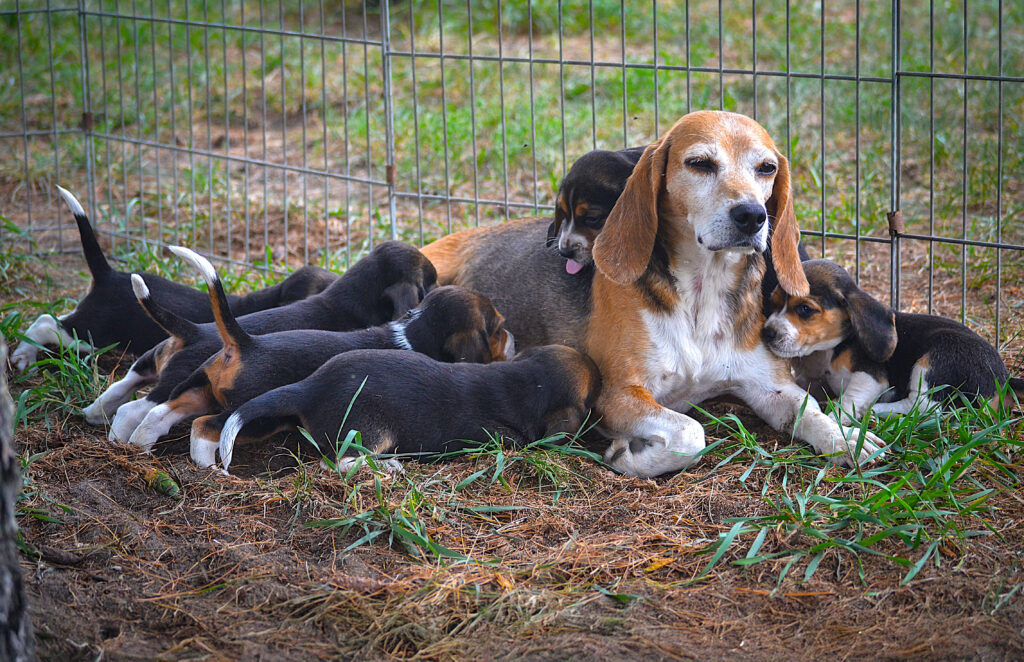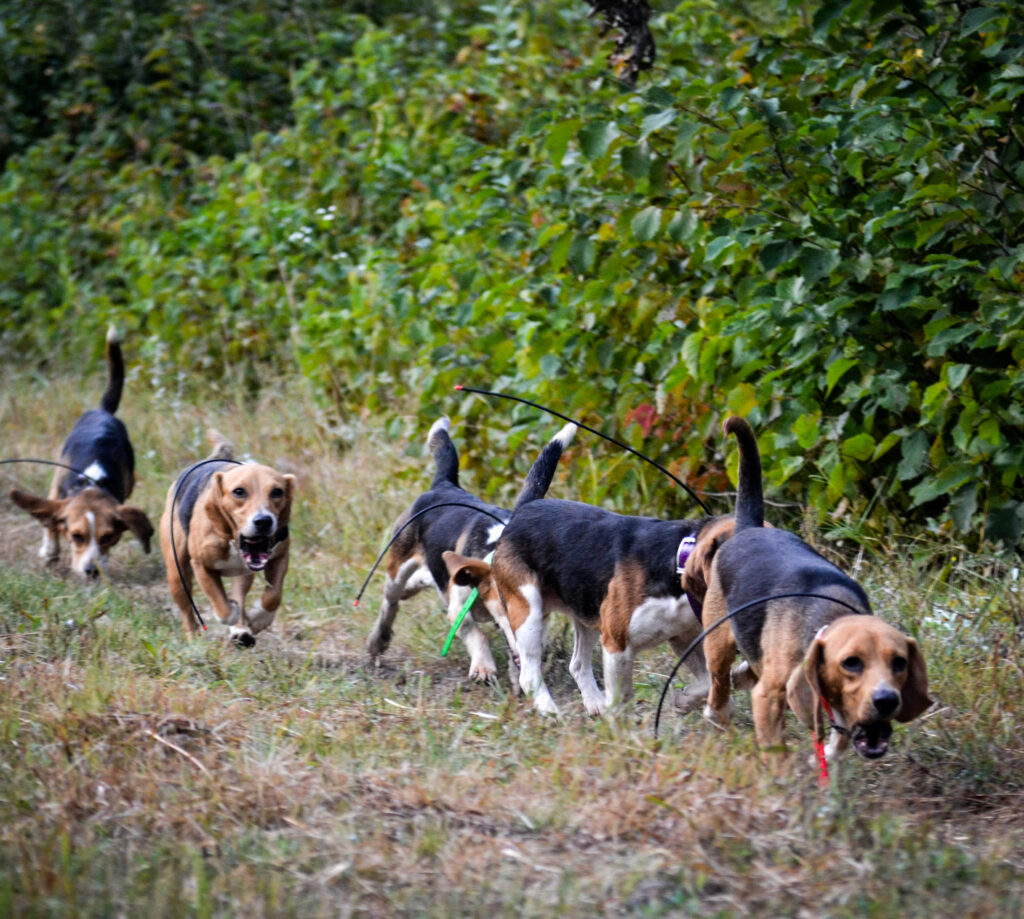Looking Into Littermate Syndrome

Is It a Benefit or a Bother to Raise Puppies from the Same Litter?
Story & Photos By Tom O’Connor
Indy and Ella are littermate sisters. Born and raised, they’ve lived and hunted together their whole lives. Watching these two females run a rabbit is like seeing two dogs with two noses and two voices but one brain. It’s like they have a Bluetooth connection. They do everything together, and even turn at exactly the same time.
I hate giving advice. It implies that I know what I’m talking about. When I start writing “advice columns” I go back and read what I wrote and it sounds just like the kind of stuff I hate to read, written by someone that thinks they know more about what’s good for me and my dogs than I do. I really don’t want to be that guy.
When it comes to dogs, I’m always learning new things and changing my opinions. I watch videos and read the advice given by professionals and I have learned a lot from them, but there are always things I come across that make me wonder if they are making this stuff up. Maybe other dogs are just that much different than beagles? Maybe some of this stuff just gets passed around without any real data to back it up?
I can’t give you recorded data but I’ve had hundreds of dogs and I have raised more than a thousand puppies. It’s been my full-time job since I was old enough to take a dog to the woods. I had a real job until I retired but I have always spent most of my time with dogs. I can’t give you the numbers because I’m really bad at keeping records. I often think that if I had kept detailed records and data of all the puppies and dogs that have touched my life, I could add something useful to the world of dog knowledge. But the truth is, I would much rather clean dog kennels than type on a computer.
What Is Littermate Syndrome?
It’s one of the latest trends with dogs. “Never get littermates or you will suffer the dreaded littermate syndrome,” the articles proclaim. When I first saw this I thought what the heck are they talking about I raise littermates all the time. I keep whole litters. Sometimes I keep one pup from a litter, but more is always better. I’ve been doing it for about 40 years. I don’t know the numbers, but I have raised lots of littermates. I have a bunch right now.
I figured this was the latest fad and would soon go away. But it hasn’t. All the experts are giving this advice nowadays. I’m not sure where this comes from. The “symptoms” they list are all over the place. Either the dogs love each other too much or they fight all the time. No one says this breed or that breed, it’s all dogs, even beagles. No reputable breeder would sell you two puppies from the same litter. I guess all these years I have been disreputable and didn’t even know it…
I can’t tell you what is suddenly happening with all these other littermates from other breeds, but I can tell you that beagles have been raised in packs for hundreds of years. It is standard practice. If there are six puppies in a litter, those six dogs live, eat, and hunt together unless one or more are “drafted,” which in the old days meant removing them from the pack. Beagles from large packs had to live together peacefully and get along without fighting or other problems. Beagles are an old “breed,” they were around long before people started separating dogs into breeds about 150 years ago. Any problems with “littermate syndrome” were dealt with long ago.

Starting Off On the Right Track
Not all beagles today come from large packs. In this country there are few formal beagle packs, but most beagles live separate from other beagles or possibly with one or two canine companions. If they develop a problem like resource guarding or fighting with their littermates not many breeders know or care about it.
I want my beagles to form a bond with each other. This happens best when they spend time together as puppies. I also give them time alone away from the other puppies. I do this by taking them for walks or letting them run loose in the yard without other dogs around.
To hunt a pack you need a group of beagles that have nearly the same speed and style of hunting. Beagles that are closely related and raised together often make a pack that hunts well together and performs at a higher level than any individual dog could alone.
There are potential problems with raising two or more beagle puppies from the same litter together. Despite being called beagles, there’s a lot of difference between individual dogs. Still, on average, there are more advantages than disadvantages to raising a beagle puppy with another from the same litter.
Pros of Raising Littermate Beagles
Beagles have been bred to live as a pack. They don’t like to be alone. If you live with a beagle, you are their pack. If you go off to work and leave them home alone they will not be happy. Having another dog around will make them feel better. A littermate will return the feeling.
Beagles—especially when they are young—have a lot of energy. Having a littermate to play with will keep them content and go a long way toward keeping them from finding destructive ways to use that energy.
Puppy play battles begin around four weeks and last into adulthood. Play fighting is an important way for dogs to learn social skills and how to get along with other dogs. Chasing each other is another type of play and usually begins later. I let my puppies run loose in the yard while I am outside and often see one puppy running by with a scrap of cloth while the other puppies chase them in full cry. This mimics hunting. When I start taking these puppies to the woods together with an older dog, they usually start hunting the first or second time out. No starting pen needed.

One of the pitfalls mentioned by those who don’t like littermates is that it is at least twice as much work to train two puppies. For me, just the opposite is true. I mostly train puppies together and if one gets rewarded for doing something desired, you can bet the others are going to be close behind making sure they don’t miss any rewards.
Cons to Raising Littermate Beagles
Resource guarding can be a real problem. It can start an all-out fight between two dogs. All dogs will protect what is theirs—it’s natural, we do it also. The level to which they take this is hardwired into them when they are born. Some will fight anything that comes near what they consider theirs. You and your attention fall into this category, along with food, bones, toys, and even things you can’t imagine any dog would want to protect. Other beagles will let anyone or any dog take anything they have without blinking. Most fall somewhere in between these two extremes. You can train this behavior out of them when it is directed at people. You can’t train it out of them when directed at another dog.
I test all my puppies by feeding them together out of one dish when they are seven to eight weeks old. I watch for any sign of aggression. I have seen young puppies get into bloody battles. More often, I will see one or two dogs dominate the food dish and one or two pups stay back until the others leave. All this is important information that I spend a lot of time searching for. Anyone breeding dogs or considering littermates needs to know this. I have never seen anyone else mention this when they are talking about littermate syndrome. Labeling a problem like resource guarding as a syndrome lets breeders think they don’t need to fix the problem, rather, they just don’t put those two dogs together.

Another issue can be dominance. With dogs, somebody has to be the boss. When the one doing the telling is their mother, an older dog, or you, they take it and learn to accept it. When the bossy one is a littermate, it is harder for them to take. Put two bosses together and it often leads to trouble. With most of the littermates I have raised, this usually happens at some point. Separating them for a few days or even a couple weeks usually solves the problem. If it doesn’t get out of hand, I like to let them work it out for themselves. Sooner or later, they will need to figure this out and find a way for everyone to be happy. After that stage passes, almost all of the littermate beagles I have raised prefer the company of their new family more than other beagles.
Some may claim another problem to be separation anxiety, but I‘ve never seen two beagles too attached they can’t get by for a time without each other. If I take one hunting or out for a walk to the river and leave the other home, the one that gets to go will not spend one second worrying about their littermate back at home. I make sure to do this so when the time comes where one dog needs to be left home alone they are used to it. The attachment issues listed under the description for littermate syndrome don’t seem to apply to beagles in my experience.
If you have two beagles that live together for 15 years and one of them dies, there is no question the survivor will miss their companion. Of course they do. It doesn’t take an expert to tell us that beagles grieve for each other. Doesn’t seem like a very good reason to deny them 15 years of happiness to me.


